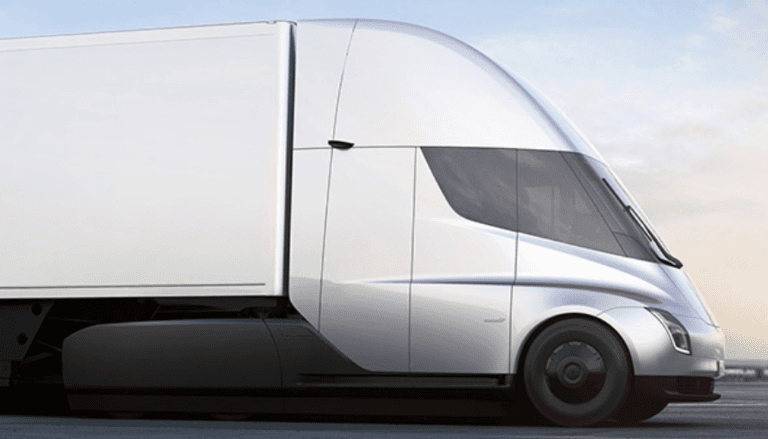
Elon Musk never disappoints with his showmanship, as in the case last week when he wowed a crowd, including media, with the Tesla Semi, an electric truck with “badass performance” that could disrupt the U.S. and even worldwide trucking industry. Then, if the Semi and its 500-mile range were not enough, out rolled a breathless red Roadster, a $200,000 gem that Musk claimed had a 620-mile range, maximum speed of 250 miles per hour and can go from zero to 60 miles per hour in 1.9 seconds.
Musk offered even more teases about the potential Tesla can offer in the near future when he suggested that the new Roadster “might” be able to exhibit some flying capabilities. Even if that were a gross exaggeration, the Roadster’s specs are impressive and could give executives at some of the leading sports car manufacturers heartburn.
Any pains or discomfort at the likes of Ferrari or Porsche, however, will likely be short-lived. After all, the Roadster is not expected to start production until 2020.
And therein lies the rub: Tesla and Musk have long had a history of over-promising and under-delivering. For a company that has yet to make an annual profit, Musk’s latest bold announcements are starting to go beyond eliciting eye-rolls to exasperation. Earlier this year, investors’ confidence in Tesla’s potential pushed the company’s market capitalization to surge ahead of GM and Ford.
The problem, however, is that Tesla’s long-term health rests on the Model 3, the mid-priced sedan that has long promised to make electric cars mainstream while disrupting the global automobile industry. Musk acknowledged that ramping up Model 3 manufacturing would catapult Tesla into “production hell” during the final months of 2017, but the number of cars rolling off its assembly line would increase exponentially by next year.
But Tesla has only produced a few hundred Model 3 cars so far, falling far short of expectations.
Investors are getting antsy, as Tesla’s stock, which was approaching $390 a share in late September, had tumbled to $300 by earlier this month. Last week’s announcement helped lift the shares’ price, and currently it is hovering about $315 a share. You’re still smiling if you purchased Tesla’s stock a year ago and have held onto it. Nevertheless, for many analysts, the Semi and Roadster come across as pie in the sky when realistically, the Model 3 should be Tesla’s bread and butter.
“Forget the Roadster and the Semi — Tesla’s fate still hinges on the Model 3,” wrote Andrew J. Hawkins for The Verge over the weekend.
For all the hype Tesla generates, and no matter how soaring Musk’s rhetoric may be, Hawkins reminds us to put the company’s impact in context:
“It’s easy to forget how small Tesla’s impact on the automotive world really is. In the five years since Tesla started producing its Model S, the company has sold about 200,000 cars. The US has more than 250 million passenger cars on the road, making the impact of this, roughly, close to zero.”
Meanwhile, Tesla is reportedly burning through cash as it tries to get the kinks worked out of its Model 3 assembly line. The company had long generated headlines for the $1,000 deposits that it required to reserve a spot in the Model 3’s wait list. Semi and Roadster buyers need to put down the same. The company will not get anywhere close to delivering on the half a million reservations made for the Model 3; if Tesla does not come close to meeting its production targets by the end of the first quarter of 2018, watch for investors to yank Tesla’s chain.
The bottom line is that the Model 3 is key to Tesla scoring both profitability and a reputation as a functional and reliable workhorse of an automaker. But Musk keeps throwing carts in front of that horse, whether they are the Semi, Roadster or solar tiles. Sooner rather than later, investors from Silicon Valley and elsewhere will finally become exasperated and look to sink their money elsewhere.
Image credit: Tesla

Leon Kaye has written for 3p since 2010 and become executive editor in 2018. His previous work includes writing for the Guardian as well as other online and print publications. In addition, he's worked in sales executive roles within technology and financial research companies, as well as for a public relations firm, for which he consulted with one of the globe’s leading sustainability initiatives. Currently living in Central California, he’s traveled to 70-plus countries and has lived and worked in South Korea, the United Arab Emirates and Uruguay.
Leon’s an alum of Fresno State, the University of Maryland, Baltimore County and the University of Southern California's Marshall Business School. He enjoys traveling abroad as well as exploring California’s Central Coast and the Sierra Nevadas.














